Abstract
Most genetic variants that contribute to disease1are challenging to correct efficiently and without excess byproducts2,3,4,5. Here we describe prime editing, a versatile and precise genome editing method that directly writes new genetic information into a specified DNA site using a catalytically impaired Cas9 endonuclease fused to an engineered reverse transcriptase, programmed with a prime editing guide RNA (pegRNA) that both specifies the target site and encodes the desired edit. We performed more than 175 edits in human cells, including targeted insertions, deletions, and all 12 types of point mutation, without requiring double-strand breaks or donor DNA templates. We used prime editing in human cells to correct, efficiently and with few byproducts, the primary genetic causes of sickle cell disease (requiring a transversion inHBB) and Tay–Sachs disease (requiring a deletion inHEXA); to install a protective transversion inPRNP; and to insert various tags and epitopes precisely into target loci. Four human cell lines and primary post-mitotic mouse cortical neurons support prime editing with varying efficiencies. Prime editing shows higher or similar efficiency and fewer byproducts than homology-directed repair, has complementary strengths and weaknesses compared to base editing, and induces much lower off-target editing than Cas9 nuclease at known Cas9 off-target sites. Prime editing substantially expands the scope and capabilities of genome editing, and in principle could correct up to 89% of known genetic variants associated with human diseases.
This is a preview of subscription content,access via your institution
Relevant articles
Open Access articles citing this article.
Recent advances in therapeutic CRISPR-Cas9 genome editing: mechanisms and applications
Molecular BiomedicineOpen Access07 April 2023
Recent advances in CRISPR-based genome editing technology and its applications in cardiovascular research
Military Medical ResearchOpen Access10 March 2023
CRISPR/Cas9-mediated targeted knock-in of large constructs using nocodazole and RNase HII
Scientific ReportsOpen Access15 February 2023
Access options
Access Nature and 54 other Nature Portfolio journals
Get Nature+, our best-value online-access subscription
$29.99 per month
cancel any time
Subscribe to this journal
Receive 51 print issues and online access
$199.00 per year
only $3.90 per issue
Rent or buy this article
Get just this article for as long as you need it
$39.95
Prices may be subject to local taxes which are calculated during checkout
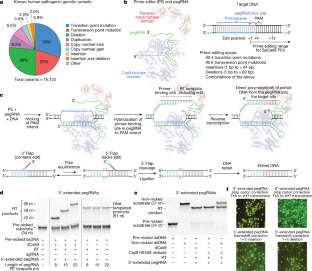
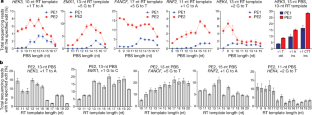
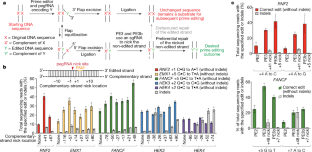
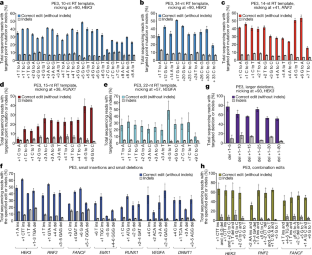
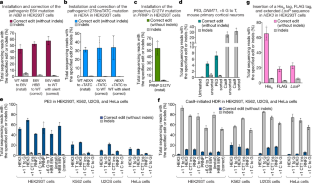
Data availability
High-throughput sequencing data have been deposited to the NCBI Sequence Read Archive database under accessionPRJNA565979. Plasmids encoding PE1, PE2 (same as PE3), and pegRNA expression vectors are available from Addgene. Previously described plasmids expressing sgRNAs are also available from Addgene, such as Addgene plasmid no. 65777.
Code availability
The script used to quantify pegRNA scaffold insertion is provided asSupplementary Note 4.
References
Landrum, M. J. et al. ClinVar: public archive of interpretations of clinically relevant variants.Nucleic Acids Res.44, D862–D868 (2016).
Jinek, M. et al. A programmable dual-RNA-guided DNA endonuclease in adaptive bacterial immunity.Science337, 816–821 (2012).
Cong, L. et al. Multiplex genome engineering using CRISPR/Cas systems.Science339, 819–823 (2013).
Mali, P. et al. RNA-guided human genome engineering via Cas9.Science339, 823–826 (2013).
Kosicki, M., Tomberg, K. & Bradley, A. Repair of double-strand breaks induced by CRISPR–Cas9 leads to large deletions and complex rearrangements.Nat. Biotechnol.36, 765–771 (2018).
Haapaniemi, E., Botla, S., Persson, J., Schmierer, B. & Taipale, J. CRISPR–Cas9 genome editing induces a p53-mediated DNA damage response.Nat. Med.24, 927–930 (2018).
Ihry, R. J. et al. p53 inhibits CRISPR–Cas9 engineering in human pluripotent stem cells.Nat. Med.24, 939–946 (2018).
Rouet, P., Smih, F. & Jasin, M. Expression of a site-specific endonuclease stimulates homologous recombination in mammalian cells.Proc. Natl Acad. Sci. USA91, 6064–6068 (1994).
Chapman, J. R., Taylor, M. R. G. & Boulton, S. J. Playing the end game: DNA double-strand break repair pathway choice.Mol. Cell47, 497–510 (2012).
Cox, D. B. T., Platt, R. J. & Zhang, F. Therapeutic genome editing: prospects and challenges.Nat. Med.21, 121–131 (2015).
Paquet, D. et al. Efficient introduction of specific homozygous and heterozygous mutations using CRISPR/Cas9.Nature533, 125–129 (2016).
Chu, V. T. et al. Increasing the efficiency of homology-directed repair for CRISPR–Cas9-induced precise gene editing in mammalian cells.Nat. Biotechnol.33, 543–548 (2015).
Maruyama, T. et al. Increasing the efficiency of precise genome editing with CRISPR–Cas9 by inhibition of nonhomologous end joining.Nat. Biotechnol.33, 538–542 (2015).
Rees, H. A., Yeh, W.-H. & Liu, D. R. Development of hRad51-Cas9 nickase fusions that mediate HDR without double-stranded breaks.Nat. Commun.10, 2212 (2019).
Shen, M. W. et al. Predictable and precise template-free CRISPR editing of pathogenic variants.Nature563, 646–651 (2018).
Rees, H. A. & Liu, D. R. Base editing: precision chemistry on the genome and transcriptome of living cells.Nat. Rev. Genet.19, 770–788 (2018).
Komor, A. C., Kim, Y. B., Packer, M. S., Zuris, J. A. & Liu, D. R. Programmable editing of a target base in genomic DNA without double-stranded DNA cleavage.Nature533, 420–424 (2016).
Gaudelli, N. M. et al. Programmable base editing of A•T to G•C in genomic DNA without DNA cleavage.Nature551, 464–471 (2017).
Gao, X. et al. Treatment of autosomal dominant hearing loss byin vivodelivery of genome editing agents.Nature553, 217–221 (2018).
Marraffini, L. A. & Sontheimer, E. J. CRISPR interference limits horizontal gene transfer in staphylococci by targeting DNA.Science322, 1843–1845 (2008).
Barrangou, R. et al. CRISPR provides acquired resistance against viruses in prokaryotes.Science315, 1709–1712 (2007).
Liu, Y., Kao, H.-I. & Bambara, R. A. Flap endonuclease 1: a central component of DNA metabolism.Annu. Rev. Biochem.73, 589–615 (2004).
Keijzers, G., Bohr, V. A. & Rasmussen, L. J. Human exonuclease 1 (EXO1) activity characterization and its function on flap structures.Biosci. Rep.35, e00206 (2015).
Baranauskas, A. et al. Generation and characterization of new highly thermostable and processive M-MuLV reverse transcriptase variants.Protein Eng. Des. Sel.25, 657–668 (2012).
Gerard, G. F. et al. The role of template-primer in protection of reverse transcriptase from thermal inactivation.Nucleic Acids Res.30, 3118–3129 (2002).
Arezi, B. & Hogrefe, H. Novel mutations in Moloney murine leukemia virus reverse transcriptase increase thermostability through tighter binding to template-primer.Nucleic Acids Res.37, 473–481 (2009).
Kotewicz, M. L., Sampson, C. M., D’Alessio, J. M. & Gerard, G. F. Isolation of cloned Moloney murine leukemia virus reverse transcriptase lacking ribonuclease H activity.Nucleic Acids Res.16, 265–277 (1988).
Nishimasu, H. et al. Crystal structure of Cas9 in complex with guide RNA and target DNA.Cell156, 935–949 (2014).
Thuronyi, B. W. et al. Continuous evolution of base editorswith expanded target compatibility and improved activity. Nat. Biotechnol.37, 1070–1079 (2019).
金,y . b . et al。增加genome-targetingscope and precision of base editing with engineered Cas9-cytidine deaminase fusions.Nat. Biotechnol.35, 371–376 (2017).
Koblan, L. W. et al. Improving cytidine and adenine base editors by expression optimization and ancestral reconstruction.Nat. Biotechnol.36, 843–846 (2018).
Tsai, S. Q. et al. GUIDE-seq enables genome-wide profiling of off-target cleavage by CRISPR-Cas nucleases.Nat. Biotechnol.33, 187–197 (2015).
Kleinstiver, B. P. et al. High-fidelity CRISPR-Cas9 nucleases with no detectable genome-wide off-target effects.Nature529, 490–495 (2016).
Bannert, N. & Kurth, R. Retroelements and the human genome: new perspectives on an old relation.Proc. Natl Acad. Sci. USA101(Suppl. 2), 14572–14579 (2004).
Halvas, E. K., Svarovskaia, E. S. & Pathak, V. K. Role of murine leukemia virus reverse transcriptase deoxyribonucleoside triphosphate-binding site in retroviral replication andin vivofidelity.J. Virol.74, 10349–10358 (2000).
Mead, S. et al. A novel protective prion protein variant that colocalizes with kuru exposure.N. Engl. J. Med.361, 2056–2065 (2009).
Asante, E. A. et al. A naturally occurring variant of the human prion protein completely prevents prion disease.Nature522, 478–481 (2015).
Kügler, S., Kilic, E. & Bähr, M. Human synapsin 1 gene promoter confers highly neuron-specific long-term transgene expression from an adenoviral vector in the adult rat brain depending on the transduced area.Gene Ther.10, 337–347 (2003).
Anzalone, A. V., Lin, A. J., Zairis, S., Rabadan, R. & Cornish, V. W. Reprogramming eukaryotic translation with ligand-responsive synthetic RNA switches.Nat. Methods13, 453–458 (2016).
Badran, A. H. et al. Continuous evolution ofBacillus thuringiensistoxins overcomes insect resistance.Nature533, 58–63 (2016).
Anders, C. & Jinek, M. inMethods in Enzymology(eds. Doudna, J. A. & Sontheimer, E. J.)546, 1–20 (Academic, 2014).
Pirakitikulr, N., Ostrov, N., Peralta-Yahya, P. & Cornish, V. W. PCRless library mutagenesis via oligonucleotide recombination in yeast.Protein Sci.19, 2336–2346 (2010).
Clement, K. et al. CRISPResso2 provides accurate and rapid genome editing sequence analysis.Nat. Biotechnol.37, 224–226 (2019).
Levy, J. M. & Nicoll, R. A. Membrane-associated guanylate kinase dynamics reveal regional and developmental specificity of synapse stability.J. Physiol. (Lond.)595, 1699–1709 (2017).
Zettler, J., Schütz, V. & Mootz, H. D. The naturally split Npu DnaE intein exhibits an extraordinarily high rate in the protein trans-splicing reaction.FEBS Lett.583, 909–914 (2009).
Li, B. & Dewey, C. N. RSEM: accurate transcript quantification from RNA-seq data with or without a reference genome.BMC Bioinformatics12, 323 (2011).
Ritchie, M. E. et al. limma powers differential expression analyses for RNA-sequencing and microarray studies.Nucleic Acids Res.43, e47 (2015).
Acknowledgements
We thank J. M. Madison for neuron cell culture advice. This work was supported by the Merkin Institute of Transformative Technologies in Healthcare, US NIH grants U01AI142756, RM1HG009490, R01EB022376, and R35GM118062, and the HHMI. A.V.A. acknowledges a Jane Coffin Childs postdoctoral fellowship. P.B.R. and A.R. acknowledge NIH T32 GM095450. A.A.S. acknowledges NIH T32 GM007726. P.J.C. and A.R. acknowledge NSF graduate fellowships. C.W. acknowledges a Damon Runyon Cancer Research Foundation fellowship (DRG-2343-18). G.A.N acknowledges a Helen Hay Whitney postdoctoral fellowship.
Author information
Authors and Affiliations
Contributions
A.V.A. designed the research, performed experiments, analysed data, and wrote the manuscript. P.B.R., J.R.D., A.A.S., and G.A.N. performed human cell experiments and analysed data. L.W.K. and J.M.L. performed neuron experiments. P.J.C. and C.W. performed and analysed RNA-seq experiments. A.R. analysed ClinVar data. D.R.L designed and supervised the research and wrote the manuscript.
Corresponding author
Ethics declarations
Competing interests
Authors through the Broad Institute have filed patent applications on prime editing. D.R.L. is a consultant and co-founder of Prime Medicine, Beam Therapeutics, Pairwise Plants, and Editas Medicine, companies that use genome editing.
Additional information
Publisher’s noteSpringer Nature remains neutral with regard to jurisdictional claims in published maps and institutional affiliations.
Peer review informationNaturethanks Guangping Gao, Randall Platt and Fyodor Urnov for their contribution to the peer review of this work.
Extended data figures and tables
Extended Data Fig. 1 In vitro prime editing validation studies with fluorescently labelled DNA substrates.
a, Electrophoretic mobility shift assays with dCas9, 5′-extended pegRNAs and 5′-Cy5-labelled DNA substrates. pegRNAs 1–5 contain a 15-nt linker sequence (linker A for pegRNA 1, linker B for pegRNAs 2–5) between the spacer and the PBS, a 5-nt PBS sequence, and RT templates of 7 nt (pegRNAs 1 and 2), 8 nt (pegRNA 3), 15 nt (pegRNA 4), and 22 nt (pegRNA 5). pegRNAs are those used ineandf; full sequences are listed inSupplementary Table 2.b, In vitro nicking assays of Cas9(H840A) using 5′-extended and 3′-extended pegRNAs. Data ina,bare representative ofn= 2 independent replicates.c, Cas9-mediated indel formation in HEK293T cells atHEK3using 5′-extended and 3′-extended pegRNAs. Mean ± s.d. ofn= 3 independent biological replicates.d, Overview of prime editing in vitro biochemical assays. 5′-Cy5-labelled pre-nicked and non-nicked dsDNA substrates were tested. sgRNAs, 5′-extended pegRNAs, or 3′-extended pegRNAs were pre-complexed with dCas9 or Cas9(H840A) nickase, then combined with dsDNA substrate, Superscript III M-MLV RT, and dNTPs. Reactions were allowed to proceed at 37 °C for 1 h before separation by denaturing urea PAGE and visualization by Cy5 fluorescence.e, Primer extension reactions using 5′-extended pegRNAs, pre-nicked DNA substrates, and dCas9 lead to substantial conversion to RT products.f, Primer extension reactions using 5′-extended pegRNAs as inbwith non-nicked DNA substrate and Cas9(H840A) nickase. Product yields are greatly reduced by comparison to pre-nicked substrate.g, An in vitro primer extension reaction using a 3′-pegRNA generates a single apparent product by denaturing urea PAGE. The RT product band was excised, eluted from the gel, then subjected to homopolymer tailing with terminal transferase (TdT) using either dGTP or dATP. Tailed products were extended using poly-T or poly-C primers, and the resulting DNA was sequenced. Sanger traces indicate that three nucleotides derived from the pegRNA scaffold were reverse-transcribed (added as the final 3′ nucleotides to the DNA product). Note that pegRNA scaffold insertion is much rarer in mammalian cell prime editing experiments than in vitro (Extended Data Fig.6), potentially owing to the inability of the tethered RT to access the Cas9-bound guide RNA scaffold, and/or cellular excision of mismatched 3′ ends of 3′ flaps containing pegRNA scaffold sequences. Data ine–gare representative ofn= 2 independent replicates. For gel source data, seeSupplementary Fig. 1.
Extended Data Fig. 2 Cellular repair in yeast of 3′ DNA flaps from in vitro prime editing reactions.
a, Dual fluorescent protein reporter plasmids contain GFP and mCherry open reading frames separated by a target site encoding an in-frame stop codon, a +1 frameshift, or a −1 frameshift. Prime editing reactions were carried out in vitro with Cas9(H840A) nickase, pegRNA, dNTPs, and M-MLV RT, then transformed into yeast. Colonies that contain unedited plasmids produce GFP but not mCherry. Yeast colonies containing edited plasmids produce both GFP and mCherry as a fusion protein.b, Overlay of GFP and mCherry fluorescence for yeast colonies transformed with reporter plasmids containing a stop codon between GFP and mCherry (unedited negative control, top), or containing no stop codon or frameshift between GFP and mCherry (pre-edited positive control, bottom).c–f, Visualization of mCherry and GFP fluorescence from yeast colonies transformed with in vitro prime editing reaction products.c,d, Stop codon correction via T•A-to-A•T transversion using a 3′-extended pegRNA (c) or a 5′-extended pegRNA (d).e, +1 frameshift correction via a 1-bp deletion using a 3′-extended pegRNA.f, −1 frameshift correction via a 1-bp insertion using a 3′-extended pegRNA.g, Sanger DNA sequencing traces from plasmids isolated from GFP-only colonies inband GFP and mCherry double-positive colonies inc. Data inb–gare representative ofn= 2 independent replicates.
Extended Data Fig. 3 Prime editing of genomic DNA in human cells by PE1.
a, sgRNA scaf pegRNAs包含间隔序列fold, and a 3′ extension containing an RT template (purple), which contains the edited base(s) (red), and a primer-binding site (PBS, green). The primer-binding site hybridizes to the nicked target DNA strand. The RT template is homologous to the DNA sequence downstream of the nick, with the exception of the encoded edited base(s).b, Installation of a T•A-to-A•T transversion at theHEK3site in HEK293T cells using Cas9(H840A) nickase fused to wild-type M-MLV RT (PE1) and pegRNAs with varying PBS lengths.c, T•A-to-A•T transversion editing efficiency and indel generation by PE1 at the +1 position ofHEK3using pegRNAs containing 10-nt RT templates and PBS sequences ranging from 8 to 17 nt.d, G•C-to-T•A transversion editing efficiency and indel generation by PE1 at the +5 position ofEMX1using pegRNAs containing 13-nt RT templates and PBS sequences ranging from 9 to 17 nt.e, G•C-to-T•A transversion editing efficiency and indel generation by PE1 at the +5 position ofFANCFusing pegRNAs containing 17-nt RT templates and PBS sequences ranging from 8 to 17 nt.f, C•G-to-A•T transversion editing efficiency and indel generation by PE1 at the +1 position ofRNF2using pegRNAs containing 11-nt RT templates and PBS sequences ranging from 9 to 17 nt.g, G•C-to-T•A transversion editing efficiency and indel generation by PE1 at the +2 position ofHEK4using pegRNAs containing 13-nt RT templates and PBS sequences ranging from 7 to 15 nt.h, PE1-mediated +1 T deletion, +1 A insertion, and +1 CTT insertion at theHEK3site using a 13-nt PBS and a 10-nt RT template. Sequences of pegRNAs are as in Fig.2a(Supplementary Table 3). Editing efficiencies reflect sequencing reads that contain the intended edit and do not contain indels among all treated cells, with no sorting. Mean ± s.d. ofn= 3 independent biological replicates.
Extended Data Fig. 4 Evaluation of M-MLV RT variants for prime editing.
a, Abbreviations for prime editor variants used in this figure.b, Targeted insertion and deletion edits with PE1 at theHEK3locus.c–h, Comparison of 18 prime editor constructs containing M-MLV RT variants for their ability to install a +2 G•C-to-C•G transversion edit atHEK3(c), a 24-bp Flag insertion at the +1 position ofHEK3(d), a +1 C•G-to-A•T transversion edit atRNF2(e), a +1 G•C-to-C•G transversion edit atEMX1(f), a +2 T•A-to-A•T transversion edit atHBB(g), and a +1 G•C-to-C•G transversion edit atFANCF(h).i–n, Comparison of four prime editor constructs containing M-MLV variants for their ability to install the edits shown inc–hin a second round of independent experiments.o–s, PE2 editing efficiency at five genomic loci with varying PBS lengths.o, +1 T•A-to-A•T atHEK3.p, +5 G•C-to-T•A atEMX1.q, +5 G•C-to-T•A atFANCF.r, +1 C•G-to-A•T atRNF2.s, +2 G•C-to-T•A atHEK4. Editing efficiencies reflect sequencing reads that contain the intended edit and do not contain indels among all treated cells, with no sorting. Mean ± s.d. ofn= 3 independent biological replicates.
Extended Data Fig. 5 Design features of pegRNA PBS and RT template sequences, and additional editing examples with PE3.
a, PE2-mediated +5 G•C-to-T•A transversion editing efficiency (blue line) atVEGFAin HEK293T cells as a function of RT template length. Indels (grey line) are plotted for comparison. The sequence below the graph shows the last nucleotide templated for synthesis by the pegRNA. G nucleotides (templated by a C in the pegRNA) are highlighted in red; RT templates that end in C should be avoided during pegRNA design to maximize prime editing efficiency.b, +5 G•C-to-T•A transversion editing and indels forDNMT1as ina.c, +5 G•C-to-T•A transversion editing and indels forRUNX1as ina.d–f, PE3-mediated transition and transversion edits at the specified positions forFANCF(d),EMX1(e), andDNMT1(f). Mean ± s.d. ofn= 3 independent biological replicates.
Extended Data Fig. 6 Comparison of prime editing and base editing, and off-target editing by Cas9 and prime editors at known Cas9 off-target sites.
a, C•G-to-T•A editing efficiency at the same target nucleotides for PE2, PE3, BE2max, and BE4max at endogenousHEK3,FANCF, andEMX1sites in HEK293T cells.b, Indel frequency from treatments ina.c, Editing efficiency of precise C•G-to-T•A edits (without bystander edits or indels) atHEK3,FANCF, andEMX1.d, Total A•T-to-G•C editing efficiency for PE2, PE3, ABEdmax, and ABEmax atHEK3andFANCF.e, Precise A•T-to-G•C editing efficiency without bystander edits or indels atHEK3andFANCF.f, Indel frequency from treatments ind.g, Average triplicate Cas9 nuclease editing efficiencies (indel frequencies) in HEK293T cells at four endogenous on-target sites and their 16 known top off-target sites32,33. For each on-target site, Cas9 was paired with an sgRNA or with each of four pegRNAs that recognize the same protospacer.h, Average triplicate on-target and off-target editing efficiencies and indel efficiencies (below in parentheses) in HEK293T cells for PE2 or PE3 paired with each pegRNA ing. Editing efficiencies reflect sequencing reads that contain the intended edit and do not contain indels among all treated cells, with no sorting. Off-target editing efficiencies inhreflect off-target locus modification consistent with prime editing. Mean ± s.d. ofn= 3 independent biological replicates.
Extended Data Fig. 7 Incorporation of pegRNA scaffold sequence into target loci.
HTS data were analysed for pegRNA scaffold sequence insertion as described inSupplementary Note 4.a, Analysis for theEMX1locus. Shown is the percentage of total sequencing reads containing one or more pegRNA scaffold sequence nucleotides within an insertion adjacent to the RT template (left); the percentage of total sequencing reads containing a pegRNA scaffold sequence insertion of the specified length (middle); and the cumulative total percentage of pegRNA insertion up to and including the length specified on thex-axis.b, As inaforFANCF.c, As inaforHEK3.d, As inaforRNF2. Mean ± s.d. ofn= 3 independent biological replicates.
Extended Data Fig. 8 Effects of PE2, PE2-dRT, Cas9(H840A) nickase, and dCas9 on cell viability and on transcriptome-wide RNA abundance.
HEK293T cells were transiently transfected with plasmids encoding PE2, PE2(R110S/K103L), Cas9(H840A) nickase, or dCas9, together with aHEK3-targeting pegRNA plasmid. Cell viability was measured for the bulk cellular population every 24 h after transfection for 3 days using the CellTiter-Glo 2.0 assay (Promega).a, Viability, as measured by luminescence, at 1, 2, or 3 days after transfection. Mean ± s.e.m. ofn= 3 independent biological replicates, each performed in technical triplicate.b, Percentage editing and indels for PE2, PE2(R110S/K103L), Cas9(H840A) nickase, or dCas9, together with aHEK3-targeting pegRNA plasmid that encodes a +5 G-to-A edit. Editing efficiencies were measured on day 3 after transfection from cells treated alongside those used for assaying viability ina. Mean ± s.d. ofn= 3 independent biological replicates.c–k, Analysis of cellular RNA, depleted for ribosomal RNA, isolated from HEK293T cells expressing PE2, PE2-dRT, or Cas9(H840A) nickase and aPRNP-targeting orHEXA针对pegRNA。对应于14410年通用电气的rnanes and 14,368 genes were detected inPRNPandHEXAsamples, respectively.c–h, Volcano plot displaying the −log10FDR-adjustedPvalue versus log2-fold change in transcript abundance for each RNA, comparing PE2 versus PE2-dRT withPRNP-targeting pegRNA (c), PE2 versus Cas9(H840A) withPRNP-targeting pegRNA (d), PE2-dRT versus Cas9(H840A) withPRNP-targeting pegRNA (e), PE2 versus PE2-dRT withHEXA-targeting pegRNA(f), PE2 versus Cas9(H840A) withHEXA-targeting pegRNA (g), PE2-dRT versus Cas9(H840A) withHEXA-targeting pegRNA (h). Red dots indicate genes that show twofold or more changes in relative abundance that are statistically significant (FDR-adjustedP< 0.05).i–k, Venn diagrams of upregulated and downregulated transcripts (twofold change or more) comparingPRNPandHEXAsamples for PE2 versus PE2-dRT (i), PE2 versus Cas9(H840A) (j), and PE2-dRT versus Cas9(H840A) (k). Values for each RNA-seq condition reflect the mean ofn= 5 biological replicates. Differential expression was assessed using a two-sidedt以及与经验贝叶斯估计方差。
扩展数据图9 PE3-mediated校正E6V-encodingHBBmutation andHEXA1278+TATCby various pegRNAs.
a, Screen of 14 pegRNAs for correction of theHBBE6V-encoding allele in HEK293T cells with PE3. All pegRNAs evaluated convert the mutantHBBallele back to wild-typeHBBwithout the introduction of any silent PAM mutation.b, Screen of 41 pegRNAs for correction of theHEXA1278+TATCallele in HEK293T cells with PE3 or PE3b. Those pegRNAs labelled HEXAs correct the pathogenic allele by a shifted 4-bp deletion that disrupts the PAM and leaves a silent mutation. Those pegRNAs labelled HEXA correct the pathogenic allele back to wild-type. Entries ending in b use an edit-specific nicking sgRNA in combination with the pegRNA (the PE3b system). Mean ± s.d. ofn= 3 independent biological replicates.
Extended Data Fig. 10 PE3 activity in human cell lines and comparison of PE3 and Cas9-initiated HDR.
a, Prime editing in K562 (leukaemic bone marrow), U2OS (osteosarcoma), and HeLa (cervical cancer) cells.b–e, Efficiency of generating the correct edit (without indels) and indel frequency for PE3 and Cas9-initiated HDR in HEK293T cells (b), K562 cells (c), U2OS cells (d), and HeLa cells (e). Each bracketed editing comparison installs identical edits with PE3 and Cas9-initiated HDR. Non-targeting controls are PE3 and a pegRNA that targets a non-target locus. (f) Control experiments with non-targeting pegRNA + PE3, and with dCas9 + sgRNA, compared with wild-type Cas9 HDR experiments confirming that ssDNA donor HDR template, a common contaminant that artificially elevates apparent HDR efficiencies, does not contribute to the HDR measurements ina–d.g, ExampleHEK3site allele tables from genomic DNA samples isolated from K562 cells after editing with PE3 or with Cas9-initiated HDR. Alleles were sequenced on an Illumina MiSeq and analysed using CRISPResso243. The referenceHEK3sequence from this region is at the top. Allele tables are shown for a non-targeting pegRNA negative control, a +1 CTT insertion atHEK3using PE3, and a +1 CTT insertion atHEK3using Cas9-initiated HDR. Allele frequencies and corresponding Illumina sequencing read counts are shown for each allele. All alleles observed with frequency ≥0.20% are shown. Mean ± s.d. ofn= 3 independent biological replicates.
Extended Data Fig. 11 Distribution by length of pathogenic insertions, duplications, deletions, and indels in the ClinVar database.
从数控下载摘要ClinVar变体BI on 15 July 2019. The lengths of reported insertions, deletions, and duplications were calculated using reference and alternate alleles, variant start and stop positions, or appropriate identifying information in the variant name. Variants that did not report any of the above information were excluded from the analysis. The lengths of reported indels (single variants that include both insertions and deletions relative to the reference genome) were calculated by determining the number of mismatches or gaps in the best pairwise alignment between the reference and alternate alleles.a, Length distribution of insertions.b, Length distribution of duplications.c, Length distribution of deletions.d, Length distribution of indels.
Supplementary information
Supplementary Information
The Supplementary Information file contains: a Supplementary Discussion that provides additional background and descriptions of the data; Supplementary Tables 1-5 listing activity data and short DNA and RNA sequences; Supplementary Sequences 1-3 that contain DNA and protein sequences of key constructs; Supplementary Notes 1-4 that contain FACS information, cloning methods, and scripts; Supplementary Figure 1 that contains original gel image data, and Supplementary References
Rights and permissions
About this article
Cite this article
Anzalone, A.V., Randolph, P.B., Davis, J.R.et al.Search-and-replace genome editing without double-strand breaks or donor DNA.Nature576, 149–157 (2019). https://doi.org/10.1038/s41586-019-1711-4
Received:
Accepted:
Published:
Issue Date:
DOI:https://doi.org/10.1038/s41586-019-1711-4
This article is cited by
Systematic optimization of Cas12a base editors in wheat and maize using the ITER platform
Genome Biology(2023)
Recent advances in therapeutic CRISPR-Cas9 genome editing: mechanisms and applications
Molecular Biomedicine(2023)
Recent advances in CRISPR-based genome editing technology and its applications in cardiovascular research
Military Medical Research(2023)
Applications of CRISPR/Cas genome editing in economically important fruit crops: recent advances and future directions
Molecular Horticulture(2023)
Prime editing for precise and highly versatile genome manipulation
Nature Reviews Genetics(2023)
Comments
By submitting a comment you agree to abide by ourTermsandCommunity Guidelines. If you find something abusive or that does not comply with our terms or guidelines please flag it as inappropriate.
